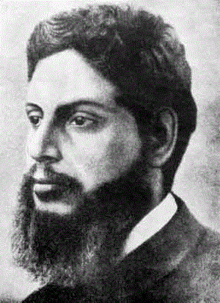Upendrakishore Raychaudhuri
Upendrakishore Raychaudhuri (also in several other Latin spellings ; Bengali : উপেন্দ্রকিশোর রায়চৌধুরী , Upendrakiśor Rāẏcaudhurī ; born May 10, 1863 in the village of Moshua, Bengal ; † December 20, 1915 in Kolkata ) was an Indian author, editor, illustrator, composer and entrepreneur.
Life
He was born in a village in the Maimansingh district in eastern Bengal . Upendrakishore was adopted by a wealthy childless uncle and took his title Raychowdhury. In the 1880s he moved to Kolkata and became a member of the Brahmo Samaj , for whom he composed hymns that are still sung today. Upendrakishore played the Esraj and Pakhawaj instruments himself . He was in contact with leading figures of the Bengali Renaissance , including the Tagore family, of which Rabindranath is still the best known today.
Upendrakishore became one of the leading block makers when he used new halftone technologies in his business and wrote technical articles about it in a British journal. He began to publish books himself, which he initially gave in foreign print. Upendrakishore Raychaudhuri sent his son Sukumar Ray to England to study printing technology at the University of Manchester . In 1913 he founded his own printing and publishing company M / s U. Roy & Sons in Kolkata, where he developed improved methods for black and white and color printing.
His work is particularly linked to Bengali children's literature. Upendrakishore made the illustrations for most of his books himself. In 1913 he was the first editor of the children's magazine Sandesh , which after his death was taken over by his son Sukumar and later his grandson Satyajit Ray and is still published. Upendrakishore published versions of the Indian epics Ramayana and Mahabharata for children, child-friendly articles on scientific topics and collections of folk fairy tales. The best known of these is Tuntunir Boi , created in 1910 - a collection of 24 animal fairy tales that has become a classic of Bengali children's literature. In 2006 the children's opera Chincha-Chancha Cooroo by Bernard Hughes , based on a story from the book, based on a libretto by William Radice, premiered. Upendrakishore Ray Choudhuri's story Goopy Gyne Bagha Byne about the adventures of two completely untalented musicians is also known from the film of the same name by Satyajit Ray.
literature
- The nine stories Narahari Das , Uncle Tiger and Nephew Jackal , The stupid crocodile , The jackal as educator , Tit and the king , The old hunchbacked woman , The old woman who loved musty rice , The farmer and the tiger and The tiger's cook (all from Tuntunir Boi ) are contained in German translation in Heinz Mode , Arun Ray (Ed.): Bengalische Märchen . Insel Verlag, Frankfurt / M. 1992, ISBN 3-458-16339-5 .
Web links
Individual evidence
- ↑ Andrew Robinson: Satyajit Ray: The Inner Eye . 1989, pp. 54 and 23
- ↑ Sukumar Ray omitted the last part of his father's surname
- ↑ Tuntuni Presents An Imaginative Treat!
- ↑ Chincha-Chancha Cooroo ( Memento of the original from March 27, 2008 in the Internet Archive ) Info: The archive link was inserted automatically and has not yet been checked. Please check the original and archive link according to the instructions and then remove this notice.
| personal data | |
|---|---|
| SURNAME | Raychaudhuri, Upendrakishore |
| ALTERNATIVE NAMES | Rāẏcaudhurī, Upendrakiśor; রায়চৌধুরী, উপেন্দ্রকিশোর (Bengali); Raychaudhuri, Upendrakisore; Raychaudhuri, Upendra Kishore; Ray Chowdhuri, Upendrakisore; Ray Chowdhuri, Upendra Kishore; Ray Chowdhuri, Upendrakishore; Raychowdhury, Upendrakisore; Raychowdhury, Upendra Kishore; Raychowdhury, Upendrakishore; Raychoudhury, Upendrakisore; Raychoudhury, Upendra Kishore; Raychoudhury, Upendrakishore; Roychoudhuri, Upendrakisore; Roychoudhuri, Upendra Kishore; Roychoudhuri, Upendrakishore |
| BRIEF DESCRIPTION | Indian author, editor, illustrator, composer and entrepreneur |
| DATE OF BIRTH | May 10, 1863 |
| PLACE OF BIRTH | Moshua village, Maimansingh |
| DATE OF DEATH | December 20, 1915 |
| Place of death | Kolkata |
